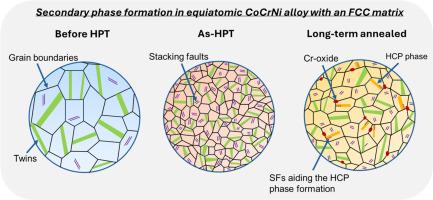等原子CoCrNi合金的相分解
IF 2.9
Q2 MATERIALS SCIENCE, MULTIDISCIPLINARY
引用次数: 0
摘要
复杂、浓缩合金(CCAs)是由多种主要元素组成的,其独特的性能引起了人们的极大兴趣。最初认为CCAs主要形成为单相结构;然而,随后的研究表明,CCAs在长时间的中等温度下可能会发生相分解。本研究研究了等原子CoCrNi合金的相稳定性,该合金通常被认为是一种单相面心立方(FCC)材料。该合金发生了严重的塑性变形,导致晶界密度高和变形诱导组织。在相图(CALPHAD)预测计算的指导下,在选定温度下进行了长时间退火,以评估其相稳定性。从微观到原子尺度的微观结构表征表明,FCC基体经历了HCP相的结构分解,并伴随着该相内的元素分配。透射电子显微镜证实了HCP相的存在,而高通量CALPHAD和混合蒙特卡罗/分子动力学模拟提供了其形成的机理。HCP相的出现,以及相关元素的再分配,解释了与先前研究的合金相比,所观察到的相组成的差异。这些发现强调了加工相关的相演化和元素分配在决定复杂浓缩合金(CCAs)性能方面的关键作用,从而影响其机械性能和在苛刻应用中的长期可靠性。本文章由计算机程序翻译,如有差异,请以英文原文为准。

Phase decomposition in the equiatomic CoCrNi alloy
Complex, concentrated alloys (CCAs) are composed of multiple principal elements in significant proportions and have attracted substantial interest due to their distinctive properties. It was initially thought that CCAs formed primarily as single-phase structures; however, subsequent research has revealed that CCAs may undergo phase decomposition when subjected to intermediate temperatures over extended durations. This study investigates the phase stability of equiatomic CoCrNi alloy, commonly recognized as a single-phase face-centered cubic (FCC) material. The alloy was subjected to severe plastic deformation, resulting in a high density of grain boundaries and deformation-induced structures. Guided by the calculation of phase diagrams (CALPHAD) predictions, prolonged annealing at a selected temperature was conducted to evaluate its phase stability. Microstructural characterization from the micro- to atomic-scale revealed that the FCC matrix undergoes structural decomposition into an HCP phase, accompanied by elemental partitioning within this phase. Transmission electron microscopy confirmed the presence of the HCP phase, while high-throughput CALPHAD and hybrid Monte Carlo/Molecular Dynamics simulations provided mechanistic insights into its formation. The emergence of this HCP phase, and the associated redistribution of elements, explains the observed differences in phase constitution compared to previously studied alloys. These findings highlight the critical role of processing-dependent phase evolution and elemental partitioning in dictating the performance of complex concentrated alloys (CCAs), thereby influencing their mechanical properties and long-term reliability in demanding applications.
求助全文
通过发布文献求助,成功后即可免费获取论文全文。
去求助
来源期刊

Materialia
MATERIALS SCIENCE, MULTIDISCIPLINARY-
CiteScore
6.40
自引率
2.90%
发文量
345
审稿时长
36 days
期刊介绍:
Materialia is a multidisciplinary journal of materials science and engineering that publishes original peer-reviewed research articles. Articles in Materialia advance the understanding of the relationship between processing, structure, property, and function of materials.
Materialia publishes full-length research articles, review articles, and letters (short communications). In addition to receiving direct submissions, Materialia also accepts transfers from Acta Materialia, Inc. partner journals. Materialia offers authors the choice to publish on an open access model (with author fee), or on a subscription model (with no author fee).
 求助内容:
求助内容: 应助结果提醒方式:
应助结果提醒方式:


